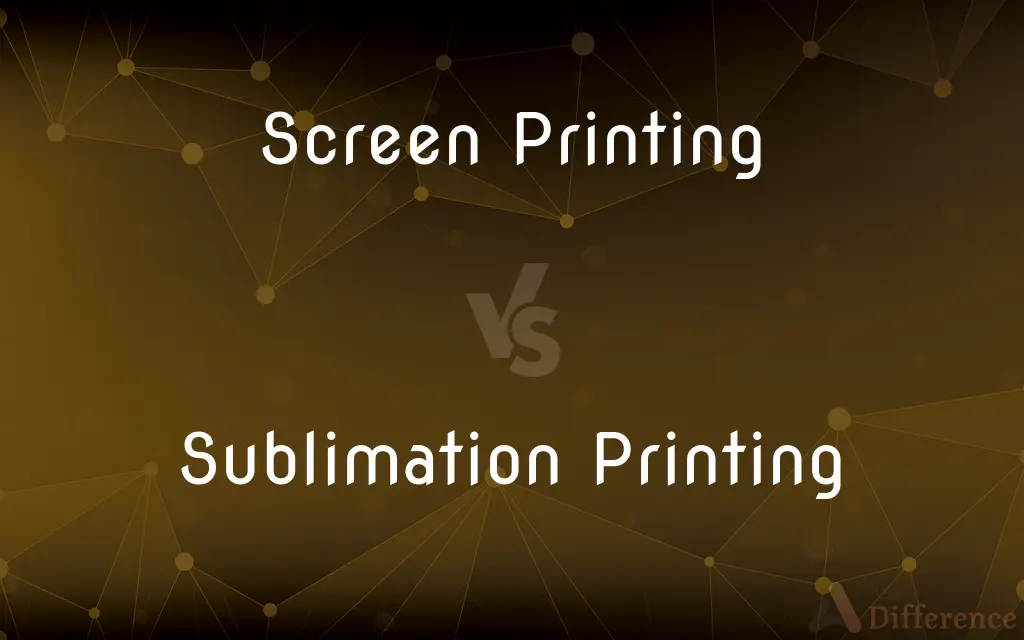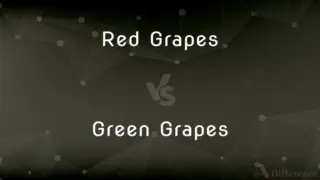Screen Printing vs. Sublimation Printing — What's the Difference?
Edited by Tayyaba Rehman — By Urooj Arif — Published on October 18, 2024
Screen printing applies ink directly onto materials, while sublimation printing uses heat to transfer dye onto substrates.

Difference Between Screen Printing and Sublimation Printing
Table of Contents
ADVERTISEMENT
Key Differences
Screen printing involves pushing ink through a mesh stencil onto the surface of a material, layering colors one at a time to create vibrant, durable designs. It is highly effective for high-volume orders and offers a wide range of colors and effects. Whereas, sublimation printing involves transferring a design from a special paper onto a substrate using heat and pressure, which turns the solid dye into a gas that permeates the material, creating a seamless, full-color image.
The inks used in screen printing sit on top of the substrate, creating a tactile texture, particularly noticeable with thicker ink applications. On the other hand, in sublimation printing, the dye becomes part of the substrate, resulting in a print that cannot be felt and will not crack, peel, or fade over time.
Screen printing is versatile, capable of being applied to a wide variety of materials, including fabrics, metals, wood, and plastics. It is particularly popular for apparel, posters, and merchandise. Sublimation printing, however, is restricted to polyester or poly-coated materials, making it ideal for items like sportswear, banners, and products that require a full-color, photographic quality finish.
The durability of screen-printed items is notable, especially on textiles, where the ink can endure numerous washes without significant fading. Sublimation prints, being part of the substrate, also boast excellent durability and resistance to washing and outdoor elements, but are limited to suitable substrates that can withstand the sublimation process.
The choice between screen printing and sublimation printing depends on the project's specifics—screen printing is preferred for simpler designs on a wide range of materials, while sublimation is ideal for complex, vibrant designs on polyester fabrics and coated items.
ADVERTISEMENT
Comparison Chart
Ink Application
Directly onto the surface, creating a tactile texture.
Dye becomes part of the substrate, seamless finish.
Durability
High, especially on textiles, resistant to washing.
High, dye is embedded in substrate, resists fading.
Material Compatibility
Wide range, including fabrics, metals, and plastics.
Limited to polyester or poly-coated materials.
Color Vibrancy
Vibrant, can use a wide range of colors and effects.
Extremely vibrant, full-color, photographic quality.
Ideal Use
High-volume orders, simpler designs, wide material range.
Full-color designs, polyester fabrics, coated items.
Compare with Definitions
Screen Printing
Results in a distinct tactile feel, especially with thicker ink layers.
High-quality printed tote bags display the textured effect of screen printing.
Sublimation Printing
Uses heat to turn dye into gas, which then permeates the substrate.
Custom sports jerseys utilize sublimation for their vibrant, full-coverage designs.
Screen Printing
Can be applied to a diverse array of surfaces.
Screen-printed posters on heavy paper or cardstock are popular for their durability and vibrant colors.
Sublimation Printing
The print becomes part of the material, offering a smooth surface.
Sublimated mugs and coasters feature smooth, detailed images without texture.
Screen Printing
Involves pressing ink through stencils to create designs, layer by layer.
Band t-shirts often use screen printing for their bold, durable designs.
Sublimation Printing
Restricted to specific substrates that can withstand high heat.
Polyester flags and banners are ideal for sublimation, showcasing vivid colors and intricate patterns.
Screen Printing
Allows for specific color matching, essential for brand consistency.
Corporate promotional items often use screen printing to ensure accurate brand colors.
Sublimation Printing
Embedded dye ensures longevity and resistance to fading.
Sublimated apparel retains its color and design integrity even after multiple washes.
Screen Printing
Cost-effective for large quantities due to reusable stencils.
Event organizers commonly opt for screen-printed merchandise for cost efficiency in large volumes.
Sublimation Printing
Capable of producing detailed, full-color images with gradients.
Photographic prints on metal or ceramics often use sublimation for sharp, vivid imagery.
Common Curiosities
Which printing method offers more vibrant colors?
Sublimation printing typically offers more vibrant, full-color, photographic-quality images compared to screen printing.
Is sublimation printing more durable than screen printing?
Sublimation prints are highly durable since the dye is embedded into the substrate, but screen printing can also be very durable, particularly on textiles, depending on the ink and application process used.
What is the setup process like for each method?
Screen printing requires creating stencils and setting up screens for each color, while sublimation printing involves printing a design onto special paper before transferring it with heat.
Can screen printing be done on any material?
While screen printing is versatile, it works best on flat, porous surfaces and may not be suitable for all materials, especially those that cannot withstand the heat and pressure required for the ink to cure.
Is sublimation printing environmentally friendly?
Sublimation printing is generally considered more environmentally friendly due to the minimal waste and absence of water usage compared to traditional screen printing processes.
Can I use sublimation printing on dark fabrics?
Sublimation printing works best on light or white fabrics since the dye is transparent and the color of the substrate can show through the print.
Can screen printing achieve full-color images?
Screen printing can achieve a wide range of colors and effects, but creating detailed, full-color images is more complex and less cost-effective than with sublimation printing.
Which method is more cost-effective for small orders?
Sublimation printing can be more cost-effective for small, custom orders due to its lower setup costs compared to screen printing, which is more economical for larger runs.
How does the feel of a printed item differ between the two methods?
Screen-printed items may have a tactile feel where the ink is applied, whereas sublimation-printed items have no change in texture since the dye is embedded into the substrate.
Which method is faster for producing a finished product?
Sublimation printing can be faster for small quantities due to less setup time, but screen printing can be quicker for large runs once the initial setup is complete.
How do the environmental impacts of the two methods compare?
Sublimation printing is often seen as more eco-friendly due to less waste and no need for water, whereas screen printing can involve solvents and other chemicals that may be harmful if not managed properly.
Can either method be used for home-based printing projects?
Sublimation printing is more accessible for home-based projects due to the compact size of the equipment and ease of setup, whereas screen printing typically requires more space and equipment.
What is the learning curve like for each printing method?
Screen printing has a steeper learning curve due to the technical aspects of screen creation and ink application, while sublimation printing is relatively straightforward, particularly with digital designs.
How do washability and care differ between the two methods?
Both methods produce washable items, but sublimation-printed items often have superior washability since the dye is part of the substrate, whereas screen-printed items may eventually fade or crack with heavy washing.
How does the choice of substrate affect the outcome of each printing method?
The substrate plays a crucial role in both methods; screen printing offers more substrate versatility, while sublimation requires substrates that are polyester-based or specially coated for the process.
Share Your Discovery

Previous Comparison
Red Grapes vs. Green Grapes
Next Comparison
Tikka vs. Tikka MasalaAuthor Spotlight
Written by
Urooj ArifUrooj is a skilled content writer at Ask Difference, known for her exceptional ability to simplify complex topics into engaging and informative content. With a passion for research and a flair for clear, concise writing, she consistently delivers articles that resonate with our diverse audience.
Edited by
Tayyaba RehmanTayyaba Rehman is a distinguished writer, currently serving as a primary contributor to askdifference.com. As a researcher in semantics and etymology, Tayyaba's passion for the complexity of languages and their distinctions has found a perfect home on the platform. Tayyaba delves into the intricacies of language, distinguishing between commonly confused words and phrases, thereby providing clarity for readers worldwide.













































